by Akim Reinhardt
 In 1790, shortly after the 13 states ratified the U.S. Constitution, the new federal government conducted its first population census. Its tabulations revealed an astonishingly rural nation. No less than 95% of all Americans lived in rural areas, either on a fairly isolated homestead (typically a farm) or in a very small town. How small? Fewer than 2,500 people. Meanwhile, just 1/20 of Americans lived in a town with more than 2,500 people. All told there were only 26 such towns, only half of which had so many as 5,000 people
In 1790, shortly after the 13 states ratified the U.S. Constitution, the new federal government conducted its first population census. Its tabulations revealed an astonishingly rural nation. No less than 95% of all Americans lived in rural areas, either on a fairly isolated homestead (typically a farm) or in a very small town. How small? Fewer than 2,500 people. Meanwhile, just 1/20 of Americans lived in a town with more than 2,500 people. All told there were only 26 such towns, only half of which had so many as 5,000 people
In a nation of nearly 4,000,000 people, the ten largest cities had a combined population of only 152,000. And half of those top ten cities did not even have 10,000 people.
Yet, even then, tensions between rural and urban interests were already evident. Urbanites, particularly elite merchants, had drawn on their power, wealth, and influence to promoting constitutional ratification. At the forefront of opposition had been small farmers.
A general theme among opponents to ratification were concerns that the new constitution aimed to create a much stronger central government. Some worried it would erode the sovereignty of the individual states. Some thought it created something too much like the despotic British government they’d just rebelled against. And some fretted about the possible loss of personal liberties; the much vaunted Bill of Rights was not part of the original document.
Debate was fierce. Historians believe it’s possible that a majority of Americans actually opposed the new Constitution. Yet it passed it eventually. During an era when voting rights were tied to personal wealth, small farmers held little political sway in most states despite their numbers. Their concerns did lead to the first 10 Amendments being added, but in the end the Federalists, particularly active in larger cities such as New York and Boston, won the day. Yet the vengeance of anti-urbanites was close at hand. Read more »
